Traduzione by CHIARA SALVADORI, volontaria di English Gratis. Il testo originale è tratto da una pagina del sito inglese di Wikipedia ed è disponibile nel rispetto della licenza Creative Commons Attribution 2.5 ![]() photo credit: The GameWay
photo credit: The GameWay

Fairy tale (1)
Fairy tale is an English language term for a type of short narrative corresponding to the French phrase conte de fée, the German term Märchen, the Italian fiaba, the Polish basn or the Swedish saga.
“Fairy tale” è il termine anglosassone per indicare un tipo di narrativa breve che corrisponde al termine francese “conte de fée”, a quello tedesco “Märchen” alla fiaba per la lingua italiana, al polacco “basn” oppure alla saga svedese.
Only a small number of the stories thus designated explicitly refer to fairies.
Solo un piccolo numero di queste storie fa esplicito riferimento alle fate.
Nonetheless, the stories may be distinguished from other folk narratives such as legends and traditions (which generally involve belief in the veracity of the events described) and explicitly moral tales, including beast fables.
Ciò nonostante, i racconti si possono distinguere da altri generi narrativi popolari come ad esempio leggende e tradizioni (che generalmente comportano la credenza nella veridicità degli eventi descritti), e racconti con la morale compresi i cosiddetti bestiari (favole aventi come protagonisti degli animali).
Fairy tales typically feature such folkloric characters as fairies, goblins, elves, trolls, giants or gnomes, and usually magic or enchantments.
Tipicamente le fiabe rappresentano personaggi folcloristici come fate, folletti, elfi, trolls, giganti o gnomi, e ,di solito, anche magia o incantesimi.
Often the story will involve a far-fetched sequence of events.
Spesso la trama comporta una sequenza di eventi inverosimili.
In less technical contexts, the term is also used to describe something blessed with unusual happiness, as in “fairy tale ending” (a happy ending) or “fairy tale romance” (though not all fairy tales end happily).
In contesti meno tecnici, il termine è inoltre utilizzato per descrivere una sensazione di beatitudine e di felicità inusuale, come per esempio nell’espressione “un lieto fine come nelle fiabe” oppure “una storia d’amore da fiaba” (sebbene non tutte le favole si concludano in modo felice).
Colloquially, a “fairy tale” or “fairy story” can also mean any far-fetched story or tall tale.
Colloquialmente, l’espressione “fairy tale” o “fairy story” può anche significare una qualsiasi storia esagerata oppure inverosimile.
>>> In cultures where demons and witches are perceived as real, fairy tales may merge into legends, where the narrative is perceived both by teller and hearers as being grounded in historical truth.
Nei contesti culturali ove demoni e streghe sono percepiti come creature reali, la favola si confonde con la leggenda, e la narrazione è vissuta sia dal narratore sia dal pubblico come se fosse fondata su una verità storica.
However, unlike legends and epics, they usually do not contain more than superficial references to religion and actual places, people, and events; they take place once upon a time rather than in actual times.
Tuttavia, diversamente dalle leggende e dalle saghe, le favole di solito non contengono se non un riferimento piuttosto approssimativo alla religione e a luoghi, persone e accadimenti reali; gli avvenimenti si sviluppano in un passato remoto piuttosto che nel presente.
Fairy tales are found in oral and in literary form.
Le fiabe sono state tramandate sia in forma orale che in forma scritta.
The history of the fairy tale is particularly difficult to trace, because only the literary forms can survive.
L’ origine della fiaba è particolarmente difficile da tracciare perché soltanto la forma scritta è in grado di giungere a noi.
Still, the evidence of literary works at least indicates that fairy tales have existed for thousands of years, although not perhaps recognized as a genre; the name “fairy tale” was first ascribed to them by Madame d’Aulnoy.
Le opere letterarie basate su fiabe dimostrano comunque che erano già esistenti da migliaia di anni, anche se probabilmente non riconosciute come genere letterario; il nome “fairy tale” venne loro attribuito da Madame d’Aulnoy.
Many of today’s fairy tales have evolved from centuries-old stories that have appeared, with variations, in multiple cultures around the world.
Molte delle fiabe che si leggono attualmente costituiscono un’evoluzione di storie antichissime apparse, con varianti, in diverse culture di tutto il mondo.
Fairy tales, and works derived from fairy tales, are still written today.
Le fiabe e le opere da esse derivate continuano ad essere scritte.
The older fairy tales were intended for an audience of adults as well as children, but they were associated with children as early as the writings of the précieuses; the Brothers Grimm titled their collection Children’s and Household Tales, and the link with children has only grown stronger with time.
Le fiabe di un tempo erano destinate ad un pubblico di adulti e di bambini, ma a partire dall’epoca delle cosiddette scrittrici précieuses vennero associate in modo specifico al mondo dell’infanzia; i fratelli Grimm intitolarono la loro raccolta di fiabe “Storie di fanciulli e di famiglia”, e il legame con il mondo dell’infanzia da allora non fece che crescere.
Folklorists have classified fairy tales in various ways. Among the most notable are the Aarne-Thompson classification system and the morphological analysis of Vladimir Propp.
Gli studiosi del folklore hanno classificato le fiabe in molti modi. Tra i più significativi ci sono il sistema di classificazione di Aarne-Thompson e l’analisi morfologica di Vladimir Propp.
Other folklorists have interpreted the tales’ significance, but no school has been definitively established for the meaning of the tales.
Altri studiosi di folclore hanno interpretato il significato delle fiabe ma nessuna scuola di pensiero è riuscita ad appurarlo definitivamente.


